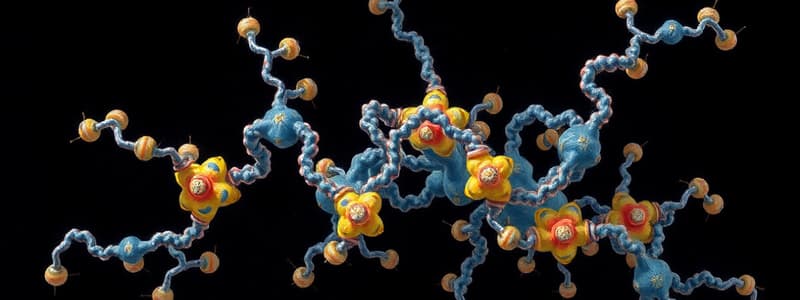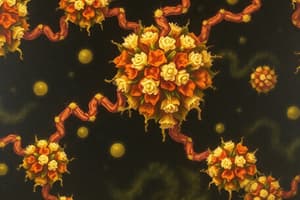Podcast
Questions and Answers
What is the primary role of soluble transport proteins in biological systems?
What is the primary role of soluble transport proteins in biological systems?
- To bind and carry specific molecules throughout the organism. (correct)
- To provide structural support to cellular components.
- To catalyze metabolic reactions within the cell.
- To regulate gene expression by directly interacting with DNA.
Which of the following best describes a ligand in the context of protein interactions?
Which of the following best describes a ligand in the context of protein interactions?
- A segment of DNA that codes for the protein sequence.
- An enzyme responsible for catalyzing the breakdown of the transport protein.
- A molecule that binds specifically to a protein, initiating a biological response. (correct)
- A structural component forming the protein's tertiary structure.
How does ligand binding to a transport protein typically initiate a signaling pathway?
How does ligand binding to a transport protein typically initiate a signaling pathway?
- By causing a conformational change in the protein that allows it to interact with other molecules. (correct)
- By entering the nucleus and altering gene transcription.
- By being metabolized into a signaling molecule.
- By directly phosphorylating downstream target proteins.
What distinguishes transport proteins from channel proteins in the context of molecular transport?
What distinguishes transport proteins from channel proteins in the context of molecular transport?
Which of the following is NOT a common mechanism by which ligand binding to a transport protein is regulated?
Which of the following is NOT a common mechanism by which ligand binding to a transport protein is regulated?
What does a lower $K_d$ value indicate regarding the interaction between a protein and a ligand?
What does a lower $K_d$ value indicate regarding the interaction between a protein and a ligand?
Myoglobin's oxygen-binding curve is best described as:
Myoglobin's oxygen-binding curve is best described as:
If myoglobin has a very low P50 for oxygen binding, what does this imply about its affinity for oxygen?
If myoglobin has a very low P50 for oxygen binding, what does this imply about its affinity for oxygen?
In the context of oxygen binding, fractional saturation ($\Theta$) is defined as:
In the context of oxygen binding, fractional saturation ($\Theta$) is defined as:
Given that 75% of myoglobin is saturated with oxygen, and the concentration of free oxygen ($O_2$) is 2.8, calculate the concentration of the $O_2$-Myoglobin complex.
Given that 75% of myoglobin is saturated with oxygen, and the concentration of free oxygen ($O_2$) is 2.8, calculate the concentration of the $O_2$-Myoglobin complex.
Myoglobin primarily functions as a(n) _______ depot for oxygen, whereas hemoglobin is mainly responsible for _______ oxygen in the blood.
Myoglobin primarily functions as a(n) _______ depot for oxygen, whereas hemoglobin is mainly responsible for _______ oxygen in the blood.
Which statement accurately compares the structural composition of myoglobin (Mb) and hemoglobin (Hb)?
Which statement accurately compares the structural composition of myoglobin (Mb) and hemoglobin (Hb)?
What structural feature is common to both myoglobin subunits and hemoglobin subunits?
What structural feature is common to both myoglobin subunits and hemoglobin subunits?
Which of the following best describes the arrangement of alpha-helices in the globin fold?
Which of the following best describes the arrangement of alpha-helices in the globin fold?
How does the quaternary structure of hemoglobin contribute to its function?
How does the quaternary structure of hemoglobin contribute to its function?
If a hypothetical protein has a structure similar to myoglobin but consists of two polypeptide chains, how would its oxygen-binding properties likely differ from myoglobin?
If a hypothetical protein has a structure similar to myoglobin but consists of two polypeptide chains, how would its oxygen-binding properties likely differ from myoglobin?
How many heme groups are present in each molecule of hemoglobin?
How many heme groups are present in each molecule of hemoglobin?
If a mutation in hemoglobin prevents the formation of the typical tetrameric structure, what is the most likely consequence?
If a mutation in hemoglobin prevents the formation of the typical tetrameric structure, what is the most likely consequence?
Which level of protein structure is primarily responsible for the globin fold observed in both myoglobin and hemoglobin subunits?
Which level of protein structure is primarily responsible for the globin fold observed in both myoglobin and hemoglobin subunits?
How does the concentration of myoglobin in muscle tissue aid in oxygen delivery during intense physical activity?
How does the concentration of myoglobin in muscle tissue aid in oxygen delivery during intense physical activity?
Which of the following is NOT a typical interaction that involves binding?
Which of the following is NOT a typical interaction that involves binding?
What is a ligand, in the context of biochemistry?
What is a ligand, in the context of biochemistry?
Which of the following is a critical characteristic of the iron atom within heme for proper oxygen binding?
Which of the following is a critical characteristic of the iron atom within heme for proper oxygen binding?
What type of interactions are primarily involved in ligand binding to a protein?
What type of interactions are primarily involved in ligand binding to a protein?
Why is the reversibility of ligand binding important for biological processes?
Why is the reversibility of ligand binding important for biological processes?
What role do the conserved histidine residues play in the function of globin proteins like myoglobin and hemoglobin?
What role do the conserved histidine residues play in the function of globin proteins like myoglobin and hemoglobin?
In the context of hemoglobin and myoglobin, what is the significance of heme being described as a prosthetic group?
In the context of hemoglobin and myoglobin, what is the significance of heme being described as a prosthetic group?
What does the association constant ($K_a$) represent in the context of protein-ligand binding?
What does the association constant ($K_a$) represent in the context of protein-ligand binding?
The following equation describes the binding affinity of a protein and ligand: $K_a = \frac{[PL]}{[P][L]}$. If the concentration of the protein-ligand compelx [PL] increases, while [P] and [L] remain constant, what happens to $K_a$?
The following equation describes the binding affinity of a protein and ligand: $K_a = \frac{[PL]}{[P][L]}$. If the concentration of the protein-ligand compelx [PL] increases, while [P] and [L] remain constant, what happens to $K_a$?
How does oxygen bind to the iron atom within the heme group of myoglobin and hemoglobin?
How does oxygen bind to the iron atom within the heme group of myoglobin and hemoglobin?
How is the dissociation constant ($K_d$) related to the affinity between a protein and a ligand?
How is the dissociation constant ($K_d$) related to the affinity between a protein and a ligand?
What is the role of the porphyrin ring in the heme group regarding iron?
What is the role of the porphyrin ring in the heme group regarding iron?
Why is the reversible binding of $O_2$ to $Fe^{2+}$ important for the function of hemoglobin and myoglobin?
Why is the reversible binding of $O_2$ to $Fe^{2+}$ important for the function of hemoglobin and myoglobin?
Two proteins, Protein A and Protein B, bind to the same ligand. Protein A has a $K_d$ of 10 nM, while Protein B has a $K_d$ of 100 nM. Which protein has a higher affinity for the ligand?
Two proteins, Protein A and Protein B, bind to the same ligand. Protein A has a $K_d$ of 10 nM, while Protein B has a $K_d$ of 100 nM. Which protein has a higher affinity for the ligand?
What type of molecule is the heme group?
What type of molecule is the heme group?
What does the fractional saturation ($\Theta$) represent in the context of protein-ligand binding?
What does the fractional saturation ($\Theta$) represent in the context of protein-ligand binding?
If the iron in heme were in the $Fe^{3+}$ state, what would be the most likely outcome?
If the iron in heme were in the $Fe^{3+}$ state, what would be the most likely outcome?
The equation for fractional saturation is given by: $\Theta = \frac{[L]}{[L] + K_d}$. If the ligand concentration [L] is equal to $K_d$, what is the value of $\Theta$?
The equation for fractional saturation is given by: $\Theta = \frac{[L]}{[L] + K_d}$. If the ligand concentration [L] is equal to $K_d$, what is the value of $\Theta$?
How does increasing the ligand concentration affect the fractional saturation ($\Theta$) of a protein, assuming $K_d$ remains constant?
How does increasing the ligand concentration affect the fractional saturation ($\Theta$) of a protein, assuming $K_d$ remains constant?
What is the primary role of the amino acid residues that interact with the heme group in myoglobin and hemoglobin?
What is the primary role of the amino acid residues that interact with the heme group in myoglobin and hemoglobin?
What is the structural relationship between myoglobin and hemoglobin subunits?
What is the structural relationship between myoglobin and hemoglobin subunits?
A scientist performs an experiment to determine the $K_d$ of a protein-ligand interaction. They measure the fractional saturation ($\Theta$) at various ligand concentrations [L]. Which of the following statements best describes how they can determine the $K_d$ from the binding curve?
A scientist performs an experiment to determine the $K_d$ of a protein-ligand interaction. They measure the fractional saturation ($\Theta$) at various ligand concentrations [L]. Which of the following statements best describes how they can determine the $K_d$ from the binding curve?
If a mutation in a protein decreases its affinity for a ligand, how would this affect the $K_d$ and the shape of the binding curve?
If a mutation in a protein decreases its affinity for a ligand, how would this affect the $K_d$ and the shape of the binding curve?
Which of the following scenarios would result in a higher fractional saturation ($\Theta$) of a protein for its ligand?
Which of the following scenarios would result in a higher fractional saturation ($\Theta$) of a protein for its ligand?
Consider a protein that binds a ligand with high affinity. Which of the listed experimental conditions would be most effective at measuring the binding affinity?
Consider a protein that binds a ligand with high affinity. Which of the listed experimental conditions would be most effective at measuring the binding affinity?
Flashcards
Soluble Transport Proteins
Soluble Transport Proteins
Proteins that bind and transport specific molecules (ligands) within a biological system.
Ligand
Ligand
A molecule that specifically binds to a protein.
Ligand Binding
Ligand Binding
Proteins form complexes with ligands to facilitate transport or signaling.
Channel Proteins
Channel Proteins
Signup and view all the flashcards
"Lygate" (Ligand-Gated Channels)
"Lygate" (Ligand-Gated Channels)
Signup and view all the flashcards
Lower Kd
Lower Kd
Signup and view all the flashcards
Myoglobin O2 Curve
Myoglobin O2 Curve
Signup and view all the flashcards
Fractional Saturation (Θ)
Fractional Saturation (Θ)
Signup and view all the flashcards
P50
P50
Signup and view all the flashcards
Myoglobin's P50
Myoglobin's P50
Signup and view all the flashcards
O₂ binding proteins
O₂ binding proteins
Signup and view all the flashcards
Myoglobin (Mb)
Myoglobin (Mb)
Signup and view all the flashcards
Hemoglobin (Hb)
Hemoglobin (Hb)
Signup and view all the flashcards
Myoglobin Structure
Myoglobin Structure
Signup and view all the flashcards
Hemoglobin Structure
Hemoglobin Structure
Signup and view all the flashcards
Myoglobin vs. Hemoglobin
Myoglobin vs. Hemoglobin
Signup and view all the flashcards
Globin Fold
Globin Fold
Signup and view all the flashcards
Globin Fold (structure)
Globin Fold (structure)
Signup and view all the flashcards
Heme Groups
Heme Groups
Signup and view all the flashcards
Myoglobin and Hemoglobin Subunits
Myoglobin and Hemoglobin Subunits
Signup and view all the flashcards
Metabolic Pathway Binding
Metabolic Pathway Binding
Signup and view all the flashcards
Affinity
Affinity
Signup and view all the flashcards
Binding Site Specificity
Binding Site Specificity
Signup and view all the flashcards
Ka (Association Constant)
Ka (Association Constant)
Signup and view all the flashcards
Kd (Dissociation Constant)
Kd (Dissociation Constant)
Signup and view all the flashcards
High Kd Implies
High Kd Implies
Signup and view all the flashcards
Kd Range Usage
Kd Range Usage
Signup and view all the flashcards
Increased Ligand Concentration Effect
Increased Ligand Concentration Effect
Signup and view all the flashcards
Binding Site Occupation
Binding Site Occupation
Signup and view all the flashcards
Determining Kd
Determining Kd
Signup and view all the flashcards
Why Weak Interactions?
Why Weak Interactions?
Signup and view all the flashcards
Specificity
Specificity
Signup and view all the flashcards
Prosthetic Group
Prosthetic Group
Signup and view all the flashcards
Heme
Heme
Signup and view all the flashcards
Reduced Iron (Fe2+)
Reduced Iron (Fe2+)
Signup and view all the flashcards
Nitrogen Atoms from Proline
Nitrogen Atoms from Proline
Signup and view all the flashcards
Conserved Histidine (His) Residues
Conserved Histidine (His) Residues
Signup and view all the flashcards
Distal Histidine
Distal Histidine
Signup and view all the flashcards
Oxygen Binding to Iron
Oxygen Binding to Iron
Signup and view all the flashcards
Reversible Oxygen Binding
Reversible Oxygen Binding
Signup and view all the flashcards
Heme in Reversible O2 Binding
Heme in Reversible O2 Binding
Signup and view all the flashcards
CO and O2 Binding
CO and O2 Binding
Signup and view all the flashcards
Study Notes
-
2.1: Intro to Soluble Transport Proteins
-
Part 1: Ligand Binding
-
Many protein functions involve binding:
- Enzymes and substrates
- Receptors and signal molecules
- Transporters and small molecules (for transport)
- DNA repair and recombination
-
A ligand is a small molecule that binds to a protein
-
Only specific binding to each particular ligand
-
Ligand binding is a reversible process involving noncovalent interactions
-
Binding induces conformation in the protein
-
Protein-ligand complex occurs through noncovalent interactions
-
Weak interactions allow for reversible ligand binding
-
Ka (Association constant) represents the equilibrium constant for the association (or binding) of protein and ligand
-
Keq = Ka = [PL]/[P][L]
- [P] = concentration of protein in M
- [L] = concentration of ligand in M
- Ka unit: M-1
-
Ka (Dissociation constant) represents the equilibrium constant for the dissociation of ligand from protein-ligand complex
-
Keq = Ka = [P][L]/[PL]
- Ka unit: M
-
Kd = 1/Ka
-
This is used more frequently for affinity measurement
-
A larger Ka means more product and lower affinity
-
High affinity correlates to low Kd/high Ka
-
Kd ranges for different interactions are useful for comparing binding affinities
-
Lowest Kd indicates high affinity
-
Highest Kd indicates low affinity
-
Examples:
- Avidin and Biotin Kd is 1 x 10^-15
- Insulin receptor and Insulin Kd is 1 x 10^-10
-
Fractional saturation (θ, theta) is the fraction of occupied protein binding sites
-
θ = occupied binding sites/total binding sites
-
θ = [L]/([L] + Kd)
-
Ligand binding can be represented by a hyperbolic curve
-
θ = [L]/([L] + Kd)
-
One can memorize this
-
Increase Ligand Concentration, an increased number of occupied binding sites on proteins will be observed
-
Kd can be determined from a binding curve
-
If Kd = [L], θ = 0.5
-
A lower Kd means a higher affinity of protein for ligand
-
The oxygen binding curve for myoglobin is hyperbolic
-
Myoglobin:
- Has very low P50 for O2 binding meaning it has a high affinity for O2, so it binds it really well
-
2.1: Intro to Soluble Transport Proteins
-
Part 2: Globin Structure
-
Myoglobin and hemoglobin are both O2 binding proteins
-
Myoglobin (Mb) is concentrated in muscle tissue
- Functions as a storage depot for O2
-
Hemoglobin (Hb) is a major protein in red blood cells (i.e., erythrocytes) – RBC
- Transports O2 in blood from the lungs to the tissues
-
Myoglobin consists of a single polypeptide chain
-
Hemoglobin contains four polypeptides
-
Myoglobin and hemoglobin subunits share the same protein fold called globin fold
-
Globin Fold: has 8 α-helix folded up into a globular structure
-
Heme is needed because none of the amino acids can interact with O2 reversibly
-
O2 reversibly binds to an iron atom in heme that is tightly bound to the protein
-
Heme is a cofactor called prosthetic group
- Essential to protein function
- Covalently bound (tightly bounded)
-
Iron must be in the Fe2+ (reduced) state to bind O2
-
The reduced state allows for reversible O2 binding
-
Heme:
- Fe2+ porphyrin complex
- Prosthetic group
- Binds one ligand
-
The amino acid sequence similarity between myoglobin and either the α or β subunit of hemoglobin is low
-
Two conserved Histidine (HIS) residues are important for oxygen binding in globin proteins:
- Oxygen is bound through the sixth coordination bond
- Distal His forms an H-bond with the O2
- O2 binds to the iron
- Proximal His forms the coordination bond with the Fe2+.
-
2.1: Intro to Soluble Transport Proteins
-
Part 3: O2 Binding Curve
-
The O2 binding curve of myoglobin is hyperbolic, whereas that of hemoglobin is sigmoidal
-
For effective O2 transport, O2 Affinity must vary with the partial pressure of O2 (pO2)
-
Oxygen binding to hemoglobin produces a sigmoidal curve because of cooperative binding
Studying That Suits You
Use AI to generate personalized quizzes and flashcards to suit your learning preferences.
Related Documents
Description
Explore the roles of soluble transport proteins and ligand interactions. Understand mechanisms, regulation, and the significance of $K_d$ values. Analyze myoglobin's oxygen-binding curve and fractional saturation.



